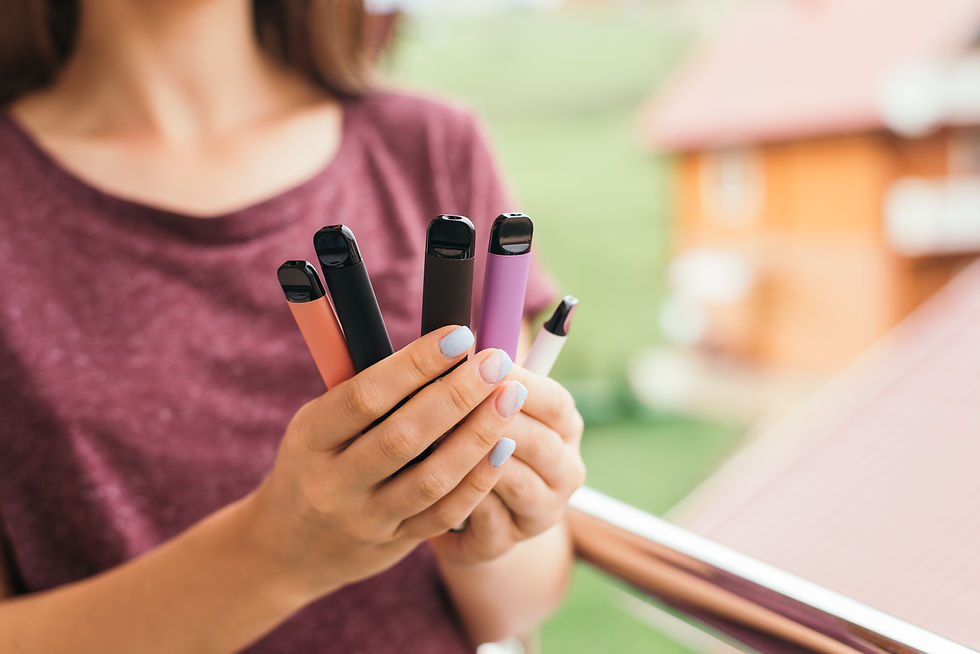The Hidden Places Teens Vape, And What Schools Can Do About It
- Zeptive

- Aug 6
- 3 min read
Updated: Aug 8
Key Points:
Teens often vape in concealed areas where adult supervision is limited
Vape devices are small, discreet, and easy to hide in everyday objects
Schools can take strategic steps to reduce on-campus vaping through policy, education, and detection
Teen vaping often doesn’t happen out in the open.
Instead, it hides, behind closed doors, in between class periods, or even within articles of clothing. According to recent studies, the places teens choose to vape are just as important as why they do it. Understanding these hidden environments is essential for schools seeking to prevent use and protect student health.
The good news? There are clear, evidence-based steps schools can take to make a difference.
The Hidden Places Teens Vape
The compact size and stealthy design of e-cigarettes have made them incredibly easy to conceal. Many devices resemble USB drives, highlighters, hoodie drawstrings, or pens. And because vaping doesn’t leave behind the telltale smell of cigarettes, it often goes undetected.
Some of the most common locations where students report vaping include:
School bathrooms and locker rooms: These are the most frequently cited spots, with limited adult presence and privacy that makes it easy to take a quick inhale.
Stairwells and hallways between classes: Moments of transition give students cover to use devices briefly before blending back into the crowd.
Inside classrooms or under desks: Especially with draw-activated “stealth vapes,” some students have admitted to using devices in class without teachers noticing.
On the bus or in cars: Transportation offers isolation and minimal monitoring, particularly on longer rides and travel to off-campus events.
During after-school activities: Clubs, sports, and rehearsals may be supervised, but not always closely enough to catch discreet use behind the scenes.
A 2022 national survey by the CDC found that 28% of high school students who vape did so on school property. That’s nearly 1 in 3.
Why It’s So Hard to Catch
In addition to the locations themselves, a few other factors make vaping difficult to detect:
Quick exhalation: Vape clouds dissipate in seconds, especially if blown into clothing or a sleeve.
Low odor: Most vape liquids, especially nicotine salts, have minimal scent or smell sweet like gum or candy.
Minimal residue: Unlike smoking, there’s no ash or lingering smoke trail.
Peer protection: Students often cover for each other, warning when adults are nearby.
As device manufacturers continue to innovate, educators and administrators face an uphill battle. But it’s one they can win with the right tools and policies.
What Schools Can Do
1. Install Vape Detectors
Modern vape detectors can sense chemical changes in the air and alert staff to potential use in bathrooms or locker rooms. These devices offer real-time, location-specific data that helps schools respond quickly and consistently.

2. Build a Clear Response Plan
A detection system is only as effective as the action that follows. Create a protocol that includes:
A graduated discipline policyCounseling or health education options
Parent communication templates
Diversion programs like the ones from Playbl, which offers a range of interactive, research-backed digital games designed to support youth in making healthier decisions. Their programs serve as ideal alternatives to suspension by focusing on education and behavior change rather than punishment.
3. Train Staff to Recognize the Signs
Provide ongoing training to teachers, maintenance staff, coaches, and other school personnel so they understand:
What vape devices look like
How students conceal use
Behavioral signs like frequent bathroom visits or irritability between classes
4. Elevate Student Voices
Peer-led programs or youth advisory boards can help shift school culture. When students take part in prevention messaging, it resonates more deeply with their peers.
5. Engage Families
Caregivers often aren’t aware of what today’s vape devices look like, or how prevalent they are. Offering informational nights, sending home visual guides, or posting resources online can keep families in the loop.
The Bottom Line
Teens are vaping on school grounds, but not always where you’d expect. By understanding the most common locations and concealment methods, schools can better protect their students.
Combining education, detection, and compassionate response ensures that youth aren’t just punished, they’re supported, informed, and empowered to make healthier choices.
By The Zeptive Team
References:
Park-Lee E, Ren C, Cooper M, Cornelius M, Jamal A, Cullen KA. Tobacco Product Use Among Middle and High School Students — United States, 2022. MMWR Morb Mortal Wkly Rep. 2022;71:1283–1285. https://www.cdc.gov/mmwr/volumes/71/wr/mm7140a3.htm
Truth Initiative. (2023). Where are kids vaping? https://truthinitiative.org
Gaiha SM, Halpern-Felsher B. A Comparison of E-cigarette Use Patterns and Perceptions Between Adolescents and Young Adults. Tob Regul Sci. 2020;6(1):30-44. doi:10.18001/TRS.6.1.4
American Lung Association. (n.d.). INDEPTH: An Alternative to Teen Nicotine Suspension or Citation. Retrieved from https://www.lung.org
Truth Initiative. (n.d.). This Is Quitting: A Quit-Vaping Program for Teens and Young Adults. Retrieved from https://truthinitiative.org/thisisquitting




Comments